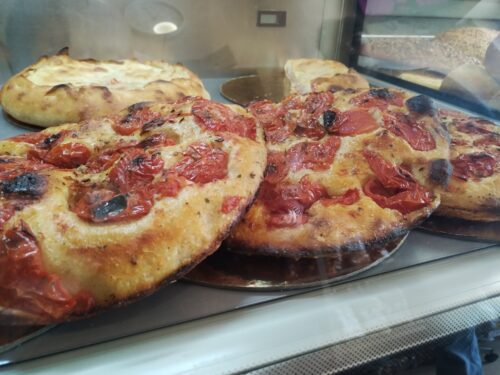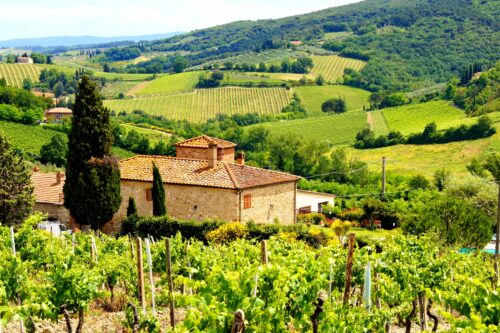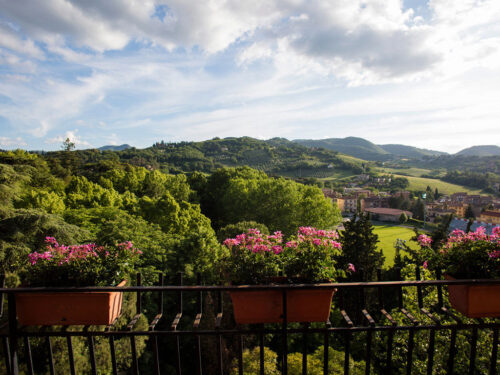 https://www.magaritours.com/wp-content/uploads/2025/05/A-local-bread-shop-in-Alberobello-500x375.jpeg
A local bread shop in Alberobello
https://www.magaritours.com/wp-content/uploads/2025/05/A-local-bread-shop-in-Alberobello-500x375.jpeg
A local bread shop in Alberobello
Why you won’t find menus in the best places to eat in Italy
Read More
If you’re looking for an authentic Italian wine tasting experience, you have two options: the typical tourist experience, or the alternative hailed as ‘Tuscany’s best kept season’…

Typical tourist experience: It’s July in Tuscany. You’re queuing for twenty minutes to get into a winery, shoulder to shoulder with other tour groups snapping selfies, everyone sipping the same wine having the same experience. The tasting feels rushed, and the “traditional lunch” could just as well be anywhere else in the world. Sound familiar?
Now imagine the alternative: It’s October. You’re wandering a vineyard at harvest, with a family who’ve made wine here for generations. Soon after, you’re at a long table where wine tasting turns into a meal, and the afternoon lingers into an evening of food, wine, and stories.
This is “La Vendemmia” (the grape harvest) and it’s the Tuscany most travellers miss – simply because they come at the wrong time.
Tuscany’s best season isn’t summer, it’s La Vendemmia – and here’s why…
So, where is the best wine in Italy? Well, we think the answer to that goes beyond just where, but when, too. When people looking for a genuinely good wine-tasting experience in Italy start exploring their options, they already assume that Tuscany will feature, (probably alongside Piedmont, Lombardy, Sicily and Puglia), however, they usually assume it’s best to enjoy in the summer. But in actual fact, they’re wrong…
Summer in Tuscany is beautiful, but it’s also the busiest season. Tour groups swarm the wineries, restaurants start rolling out menus designed for tourists, not locals, and even the “authentic” experiences can feel a little rushed. The region is still stunning, but the pace and crowds can hide its real charm.
Come autumn, everything changes. La Vendemmia, which takes place from late August through October, is when Tuscany slows down and takes off its tourist costume. This is when families return to the vineyards, continuing wine-making traditions that go back centuries.
Forget everything you think you know about wine tasting in Tuscany. During La Vendemmia, it’s nothing like the polished, predictable tastings of summer. At the small family estates Magari partners with, like Bindella Wine Estate, you don’t follow a tasting menu or listen to scripted explanations, you taste wine straight from the barrel in the cellar – as the family explains what makes this year different.
If you’ve ever wondered “what is a Montepulciano wine”, La Vendemmia is the time to find out. It’s more than a grape – it’s a wine shaped by the hillside, the soil, and the family who makes it. With Magari, you walk the vineyards, hear the traditions, and taste the wines that carry that history in every glass.
When the work is done, you settle in for an evening that teaches you Tuscany in the way guidebooks never can. This is when you learn to order wine in Italy the way it’s meant to be – not from an app, but from sharing time with people who live and breathe it. Saying “Vorrei un bicchiere di vino locale” feels natural when you’ve seen that very wine being made, barrel by barrel, and taking part in the harvest itself.
Tony Flanagan, Magari Tours Director, commented: “What makes the real memories is the experiences – the local artisan experiences. That is the key element of a Magari tour. We are taking you to masseria farms or organic vineyards. And you will be in their home talking to them about their focaccia, or mozzarella, or wines. So we pepper our itineraries with real authentic local artisan experiences. We might say that we are doing something but we won’t specially say where. We want it to be exclusive, we want it to be private, we want it to be for our guests.”
Being in Tuscany during La Vendemmia is about tasting, picking, and taking a piece of the region home with you. Here’s how to experience it like a local.

Don’t just stick to the selection of wines that a winery puts in front of you. Ask the winemaker what they’re drinking this year. Locals rarely reach for the big tourist-label bottles; instead, they’ll point you to something small-batch or newly released that really captures the spirit of this year’s vintage. Tasting wine from the barrel alongside bottles that have been ageing for years is a rare chance to understand how wine ages over time.
Skip the English menus with “Chianti Classico €8/glass.” The best value, and often the most authentic glass, is usually the vino della casa (house wine) or vino locale (local wine). A few useful phrases to try are:
Using these, you’ll almost always get something fresh, regional, and more interesting than what’s on the printed menu.
Italy has countless remarkable wine regions, but five stand out time and again:
With Magari, you can explore Tuscany, Sicily, and Puglia in a way few travellers get to – visiting family-run vineyards, tasting wines straight from the barrel, and discovering the stories behind every vintage.
Fallen in love with a bottle? You’re probably asking yourself: Can I bring back wine from Italy? The short answer is yes – you can bring wine home from Italy, but there are rules on how much and how to declare it. Here’s what you need to know before you pack your favourites:
In the UK, you can bring back up to 18 litres (around 24 bottles) of still wine without paying duty. Go over that limit and you’ll have to pay tax on everything – not just the extra litres. This tax can quickly add up, even on an extra 2 litres, so it’s worth planning how much you buy. The simplest approach is to choose your favourites carefully and enjoy a few truly special bottles, rather than trying to fill every suitcase.
If you bring back more than the UK duty-free allowance of 18 litres, customs will charge duty on every litre, not just the extras:
Even a few extra bottles can cost almost £100 in duty and VAT. The easiest way to avoid surprises is to stick to the 18-litre allowance, or have your wine shipped directly from the vineyard.
If you go over the limit, always declare all the wine you’re bringing back – not just the bottles over the allowance. You’ll usually need:
Skip the duty-free – the best bottles are always found at the source – straight from a vineyard or an enoteca (wine shop) in town. Buying direct ensures quality, and also supports the local families and small estates who make these wines by hand.
Many vineyards offer international shipping. They’ll package the wine securely, handle the customs paperwork, and make sure it arrives safely at your door. It’s the best option if you want a case or rare bottles without worrying about luggage limits – or the hassle of hauling a suitcase packed chock full of bottles through a busy airport.
If you prefer to bring bottles back home yourself, use padded wine sleeves (easy to find online) or wrap them up in bubble wrap. Pack them in the middle of your hold luggage, surrounded by clothes for cushioning. Taking wine in your hand luggage won’t be an option, and airport security will confiscate it, so putting it in your hold luggage is the way to go.
Want to experience Italy off the beaten path? Start by exploring where to go in Italy when you think you’ve seen it all – then step into Tuscany during La Vendemmia, the grape harvest season most travellers miss.
Our autumn tours take you straight into the heart of harvest season with families who have been making wine for generations. Tuscany’s best-kept secret isn’t a hidden trattoria or a quiet hilltop village – it’s timing, visiting when Tuscany is at its most alive and unforgettable.
As Tony puts it: “On a Magari tour, we don’t just want you to taste wines, we want to show you how family-run agritourismos use artisanal methods to produce exceptional wines with tradition and passion. We want you to walk amongst the vines with the winemaker before sitting down to a delicious lunch paired with the wines you’ve just heard all about in the fields and in the wine cellar. That is the Magari difference!”
Browse our autumn holiday packages and see why La Vendemmia can change the way you experience Italy. And if you’re still wondering “can you bring wine home from Italy,” the answer is yes – and our tours show you the very best bottles to take with you.
For more information or to plan your perfect harvest escape, get in touch with us today.
 https://www.magaritours.com/wp-content/uploads/2025/05/A-local-bread-shop-in-Alberobello-500x375.jpeg
A local bread shop in Alberobello
https://www.magaritours.com/wp-content/uploads/2025/05/A-local-bread-shop-in-Alberobello-500x375.jpeg
A local bread shop in Alberobello
Read More
 https://www.magaritours.com/wp-content/uploads/2024/01/Tuscany-Italy-500x333.jpg
Tuscany, Italy. A typical view of a villa and rolling Tuscan countryside with vineyards all around.
https://www.magaritours.com/wp-content/uploads/2024/01/Tuscany-Italy-500x333.jpg
Tuscany, Italy. A typical view of a villa and rolling Tuscan countryside with vineyards all around.
Read More
 https://www.magaritours.com/wp-content/uploads/2025/08/Hotel-dei-Duchi-view-from-junior-suite-balcony-500x375.jpg
Hotel dei Duchi view from junior suite balcony
https://www.magaritours.com/wp-content/uploads/2025/08/Hotel-dei-Duchi-view-from-junior-suite-balcony-500x375.jpg
Hotel dei Duchi view from junior suite balcony
Read More